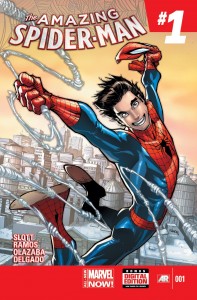 Amazing Spider-Man #1 — Writer: Dan Slott; Art: Humberto Ramos; Inks: Victor Olazaba
Amazing Spider-Man #1 — Writer: Dan Slott; Art: Humberto Ramos; Inks: Victor Olazaba
So, the odds of Marvel releasing a new Spider-Man #1, with Peter Parker back to normal, 24 hours before the debut of the new Spider-Man movie, were… 100%. Amazing! Canny, too — the editorial and creative teams deserve a lot of credit for taking the “old” Spidey away from us for so long, and building up anticipation for his return; I think we’ve all missed him. Good to have him back, too — the “standard” cover on this book seems a little goofy at first, but it’s a good example of Ramos’s loose, energetic style, and the broadly-grinning Parker signals a return to the wisecracking, infectious fun that Superior Spider-Man was (deliberately) missing. Marvel must be happy, too, since they moved over a half-million of these books, at $5.99 each — for that, fans get a 19-page main story, and then a series of five or six shorts (mostly five pages each) that set up future tales, either in this (Electro; Black Cat) or in other Spidey-related titles (Spider-Man 2099, say, written by Peter David, which debuts in a month or two, or the “Spider-Man Year One”-ish Amazing Spider-Man #1.1, 1.2, etc.). There’s also a reprint of the recent Inhuman #1, but that seems more like a calculated corporate add-on with no connection to the title, a way to encourage interest in the whole lagging Inhumanity thing. Even so, there’s more than enough for fans here — and for less than the price of a movie ticket, too.
 Southern Bastards #1 — Writer: Jason Aaron; Art: Jason Latour
Southern Bastards #1 — Writer: Jason Aaron; Art: Jason Latour
Another Image #1 book, from a major mainstream writer, and it turns out to be a Southern-Gothic story about the son of a now-dead sheriff returning to the small Alabama town where he grew up. Think Aaron’s earlier well-received Scalped, but in the Southeast instead of the Southwest, with a sharply-realized cast of lowlifes, waitresses, thugs and losers, all wrapped in Confederate flags and kudzu, and decaying in the heat. Latour’s art is a good match for Aaron’s words (they each talk in the editorial material about growing up in the South, and both loving and hating it, and those duel emotions come through in both the text and the visuals), and if you miss the kind of flinty-eyed, hardboiled mayhem that, say, 100 Bullets used to deliver regularly, this is the comic for you.
 Vertigo Quarterly: Cyan #1 (of 1) — Creators: Various
Vertigo Quarterly: Cyan #1 (of 1) — Creators: Various
Why is the cover of this book all in blue, with those little C/M/Y/K letters centered in it? Good question — and you have to turn all the way to the back for an explanation: this is the first of a quarterly anthology comic from Vertigo, and the gimmick is that each issue will focus on stories that use one of the four primary colors that four-color comics are printed from (cyan for this one, and then magenta, yellow and black — no, I don’t know why they use the last letter in “black,” either) as an inspiration or jumping-off point. Okay, although with a cover price of $7.99 I’m not sure that confusing potential readers about the purpose or contents of the book is such a smart move. Like all anthologies, though, this rises or falls on the strength of its individual content, and the batting average here is pretty good: nine eight-page (mostly) stories, generally either sf or noir or both: the last one is by Fabio Moon, and is both the quietest and the most polished, but “Much Ado About Nothing,” by Monty Nero and Al Davison, is the most imaginative and memorable, and could have been a cool Twilight Zone episode if they’d had access to today’s CGI. “Serial Artist,” by Shaun Simon and Tony Akins, and “So Blue,” by Amy Chu and Alitha Martinez, are also good (although they have similar main characters), while “Rebolt,” by Cris Peter and Ana Koehler, and “Once Upon the End of Time,” by James Tynion IV and Martin Morazzo, look like they could have stepped out of a decent Heavy Metal issue, as does the pleasantly-surreal “Blue Sundae,” and the others all have at least a striking moment or two. As a showcase of current and up-and-coming talent, this is effective — providing that readers can get past the packaging.
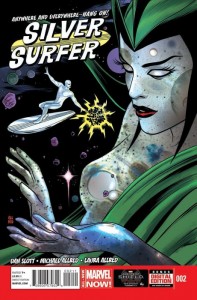 Silver Surfer #2 — Writer: Dan Slott; Art: Michael Allred
Silver Surfer #2 — Writer: Dan Slott; Art: Michael Allred
Slott, who’s been doing such yeoman work over on the Spider-Man books, shows his versatility here, with a similar sense of fun but a much more cosmic/surreal tone. This is helped greatly by the wonderful Michael Allred on art; his open, generous pop-art-inspired panels and layouts turn out to fit the Surfer and his alien milieu perfectly, and by the end of this second issue it’s clear that this is a team that’s starting to gel well. In a perfect world, this would be a best-seller, but let’s at least hope that it becomes the kind of critical darling and funky niche book that ends up with a long and fondly-remembered run.
 Batgirl Annual #2 — Writer: Gail Simone; Art: Robert Gill and Javier Garron
Batgirl Annual #2 — Writer: Gail Simone; Art: Robert Gill and Javier Garron
Almost anything by Simone is worth a look (fans still miss her tough-as-nails, ground-breaking Secret Six), and an annual like this gives her some room to stretch out, as she focuses on the Batgirl/Poison Ivy relationship, along the way reconciling some plot threads from Birds of Prey, and coming up with an interesting take on Ivy’s sometimes-conflicting personalities. The art’s not startling, but it’s smooth and attractive enough, and this is a model of a one-shot story, well-constructed and entertaining enough to justify buying it.
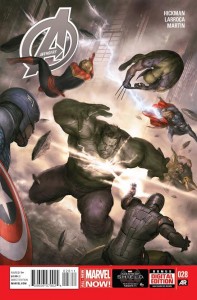 Avengers #28 — Writer: Jonathan Hickman; Art: Salvador Larroca
Avengers #28 — Writer: Jonathan Hickman; Art: Salvador Larroca
New Avengers #17 — Writer: Jonathan Hickman; Art: Rags Morales
Avengers World #5 — Writers: Jonathan Hickman and Nick Spencer; Art: Stefano Caselli
Oh, Marvel: four Avengers books in one week? Really? Sigh… well, the three Hickmans are all part of his sprawling, interconnected current continuity with the team; Avengers has been following the aftereffects of the latest schemes by the scientific bad guys of A.I.M., as  they’ve pulled a (mostly) evil alternate-Avengers team out of the multiverse who end up confronting “our” heroes; that team is gone, but it turns out one player is left…. most of the issue is a conversation between Bruce Banner and Tony Stark (which is quite a bit less boring than you might think), but it also sets up changes to the Illuminati and the mapmakers, major pieces of the overall puzzle. New Avengers is mostly about the biggest puzzle piece: the Illuminati, the secret council led by Marvel’s most powerful heroes, who’ve been dealing with nothing less than the collapse of the multiverse, and a series of ethically-challenging decisions about alternate dimensions that have to be destroyed before they do
they’ve pulled a (mostly) evil alternate-Avengers team out of the multiverse who end up confronting “our” heroes; that team is gone, but it turns out one player is left…. most of the issue is a conversation between Bruce Banner and Tony Stark (which is quite a bit less boring than you might think), but it also sets up changes to the Illuminati and the mapmakers, major pieces of the overall puzzle. New Avengers is mostly about the biggest puzzle piece: the Illuminati, the secret council led by Marvel’s most powerful heroes, who’ve been dealing with nothing less than the collapse of the multiverse, and a series of ethically-challenging decisions about alternate dimensions that have to be destroyed before they do 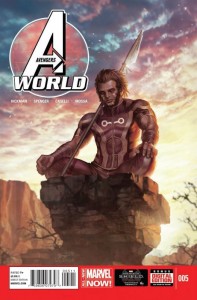 the same to “us.” Here, Prince Namor and the Black Panther are remotely observing one such dimension’s heroes — a Justice League analog, as it turns out — and manage to (a) partially bond, and (b) encounter a surprise at the end that promises a very interesting next issue. Avengers World has also been about A.I.M., but also about a number of other threats, and the last few issues have followed individual members or small groups of Avengers, and gotten them all into trouble; this issue focuses on the group teleporter, Manifold, and sets up a resolution/fight for the next issue (which makes sense, since that would be issue six, and trade collections normally involve just that many comics collected together). The artists for all three books — Larroca, Morales and Caselli — have similar shadowy styles, which fit well with the dense, complicated machinations of the various characters; this Hickman era has been intriguing, and undeniably well-constructed, but also long, with an endgame that’s remained distant and vague — sometimes frustratingly so. It should start rounding into shape quickly, though, since he said in an interview this week that he’s got just about one year left on the books — if his planning is as clever as it’s been in the past, here’s hoping that everything starts to fall neatly into place, and leads to an explosive, satisfying conclusion to make the last few years worth the journey — and clear the way for some brighter, shorter and sunnier tales for a while.
the same to “us.” Here, Prince Namor and the Black Panther are remotely observing one such dimension’s heroes — a Justice League analog, as it turns out — and manage to (a) partially bond, and (b) encounter a surprise at the end that promises a very interesting next issue. Avengers World has also been about A.I.M., but also about a number of other threats, and the last few issues have followed individual members or small groups of Avengers, and gotten them all into trouble; this issue focuses on the group teleporter, Manifold, and sets up a resolution/fight for the next issue (which makes sense, since that would be issue six, and trade collections normally involve just that many comics collected together). The artists for all three books — Larroca, Morales and Caselli — have similar shadowy styles, which fit well with the dense, complicated machinations of the various characters; this Hickman era has been intriguing, and undeniably well-constructed, but also long, with an endgame that’s remained distant and vague — sometimes frustratingly so. It should start rounding into shape quickly, though, since he said in an interview this week that he’s got just about one year left on the books — if his planning is as clever as it’s been in the past, here’s hoping that everything starts to fall neatly into place, and leads to an explosive, satisfying conclusion to make the last few years worth the journey — and clear the way for some brighter, shorter and sunnier tales for a while.
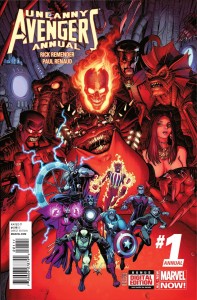 Uncanny Avengers Annual #1 — Writer: Rick Remender; Art: Paul Renaud
Uncanny Avengers Annual #1 — Writer: Rick Remender; Art: Paul Renaud
Deadly Class #4 — Writer: Rick Remender; Art: Wes Craig
Remender’s Uncanny Avengers has been offering an alternative to the interconnected main titles: it’s been in the six-issue for-the-trade format, too, but self-contained and unconcerned with whatever’s going on in the other books. That’s let it take a similar widescreen approach (The Red Skull! Kang! Alternate futures!), but one that’s both more bombastic and less imposing than Hickman’s. Here, in the Annual, we get a stand-alone story involving Mojo, the obese otherworldly media maven who’s been an X-Men bad guy for decades, and it’s simultaneously a refreshing romp and a sly satire of the creative process in the modern technological era (TV execs on Mojo’s planet want a hit show, so he kidnaps the U. A. team and they end up in the kind of high-school soap-opera show that the CW or WB would air. There’s enough action (including guest-star the Ghost Rider) to keep things moving, and a number of pointed ideas about how management-by-committee screws up the creative process: a theme that’s as much a lesson for, say, corporate comics as it is for the TV industry. It’s clever and energetic, if a bit broadly played — just the kind  of thing Chris Claremont would have knocked off for an annual 20 years ago (and, yes, that’s a compliment). If you want to see the same writer with non-corporate characters, then check out Deadly Class #4, Remender and Craig’s Breakfast Club-via-Natural Born Killers book about a high school for young assassins; in this issue, there’s a very Hunter S. Thompson-flavored trip to Las Vegas, with a couple of great art touches (a splash page at a Grateful Dead concert, for one, followed by some trippy art, in a couple of senses), and a cliffhanger that should keep readers coming back for more. This is a passionate and interesting book, and a good example of why Image offers such a tempting platform for so many creators right now.
of thing Chris Claremont would have knocked off for an annual 20 years ago (and, yes, that’s a compliment). If you want to see the same writer with non-corporate characters, then check out Deadly Class #4, Remender and Craig’s Breakfast Club-via-Natural Born Killers book about a high school for young assassins; in this issue, there’s a very Hunter S. Thompson-flavored trip to Las Vegas, with a couple of great art touches (a splash page at a Grateful Dead concert, for one, followed by some trippy art, in a couple of senses), and a cliffhanger that should keep readers coming back for more. This is a passionate and interesting book, and a good example of why Image offers such a tempting platform for so many creators right now.
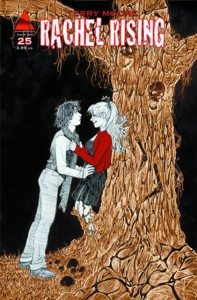 Rachel Rising #25 — Writer/Artist: Terry Moore
Rachel Rising #25 — Writer/Artist: Terry Moore
There was a big-bang climax and a logical conclusion to the story last issue, but Moore’s continuing it, and good for him; the characters — particularly Zoe, the casually-homicidal not-quite-actually-a-little-girl — are fun to watch, especially as they interact, and a formidable group. As they realize they have at least one piece of unfinished business left, and set out to accomplish it, that’s welcome news to readers who’d like to keep following their adventures.
 All-New X-Men #26 — Writer: Brian Michael Bendis; Pencils: Stuart Immonen; Inks: Wade von Grawbadger
All-New X-Men #26 — Writer: Brian Michael Bendis; Pencils: Stuart Immonen; Inks: Wade von Grawbadger
Like Deadly Class, this is an issue that’s about moving around and setting up pieces, with lots of patented Bendis character-talk stuff to keep us busy (particularly an old Scott/young Jean conversation, and Kitty’s reaction to it). Coming out twice a month allows for more “breather” issues like this, and it’s a good change of pace, even as it culminates in a big action scene… next issue, apparently, if the last page is any indication (and I’d been wondering where those characters had been…).
 Dexter’s Laboratory #1 — Writer: Derek Fridolfs; Art: Ryan Jampole
Dexter’s Laboratory #1 — Writer: Derek Fridolfs; Art: Ryan Jampole
The ’90s cartoon nostalgia revival continues apace, although in reverse order (Samurai Jack was created after Dexter’s Lab (by the same guy), but that comic has been back for a while now). Fans of the Dexter cartoon should appreciate this comic, which catches both the style and the voice of the characters well (Dexter’s mad-scientist vocal mannerisms often skate close to, but don’t quite reach, Jerry Lewis/Professor Frink territory); it ends on a cliffhanger, which is either (a) unfair to little kids, or (b) a great way of teaching them the pleasures of waiting for a monthly installment of a serial book.



